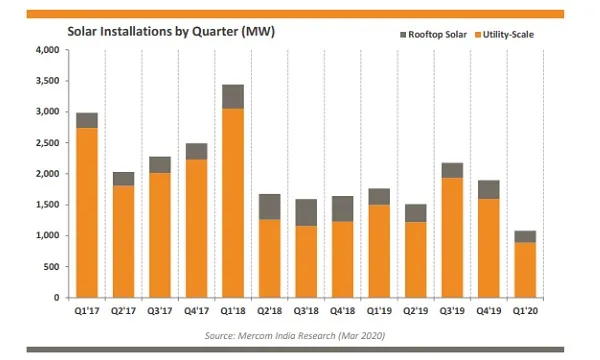
India's solar installations crashed 43% to 1.08GW in Q1
Supply disruptions caused by shutdown in China contributed to the decline.
Solar installations in India crashed 43% to 1.08GW in Q1, the lowest in a quarter since Q4 2016, compared to 1.897GW in Q4 2019, according to data from Mercom India Research. On a YoY basis, installations fell 39% compared to 1.761GW in Q1 2019.
This was attributed to lockdowns imposed on the entire country due to the coronavirus pandemic since 25 March, as well as the supply disruption caused by the shutdown in China as the reasons for solar installation declines in the quarter.
Large-scale installations accounted for 82% of new installations, whilst rooftop solar made up 18%. Rooftop solar installations dropped 36% QoQ to 194MW. Meanwhile, large-scale solar projects totaled 886MW.
Andhra Pradesh was the top installer in the country in terms of newly added large-scale solar capacity, followed by Rajasthan and Maharashtra.
The country’s cumulative solar installations hit 36.8GW at the end of the quarter, with solar represented around 9.8% of India’s total installed power capacity. Despite the COVID-19 crisis, over 13.8GW of solar projects were tendered and around 3.5GW were auctioned.
Mercom projects new installations to hit 5GW for 2020, as project timelines are extended and moved to 2021. Large-scale solar project pipeline for India stood at 36.9GW, with 38.8GW tendered and pending auctions at the end of Q1.
Furthermore, solar power generation surged 30% QoQ to 15.3 billion units (BU) during the quarter. Electricity generated from solar during FY 2019-20 accounted for 3.6% of the country-wide generation, compared to 2.85% in FY 2018-19.








![Cross Domain [Manu + SBR + ABF + ABR + FMCG + HBR + ]](https://cmg-qa.s3.ap-southeast-1.amazonaws.com/s3fs-public/styles/exclusive_featured_article/public/2025-01/earth-3537401_1920_4.jpg.webp?itok=WaRpTJwE)
![Cross Domain [SBR + ABR]](https://cmg-qa.s3.ap-southeast-1.amazonaws.com/s3fs-public/styles/exclusive_featured_article/public/2025-01/pexels-jahoo-867092-2_1.jpg.webp?itok=o7MUL1oO)









 Advertise
Advertise


